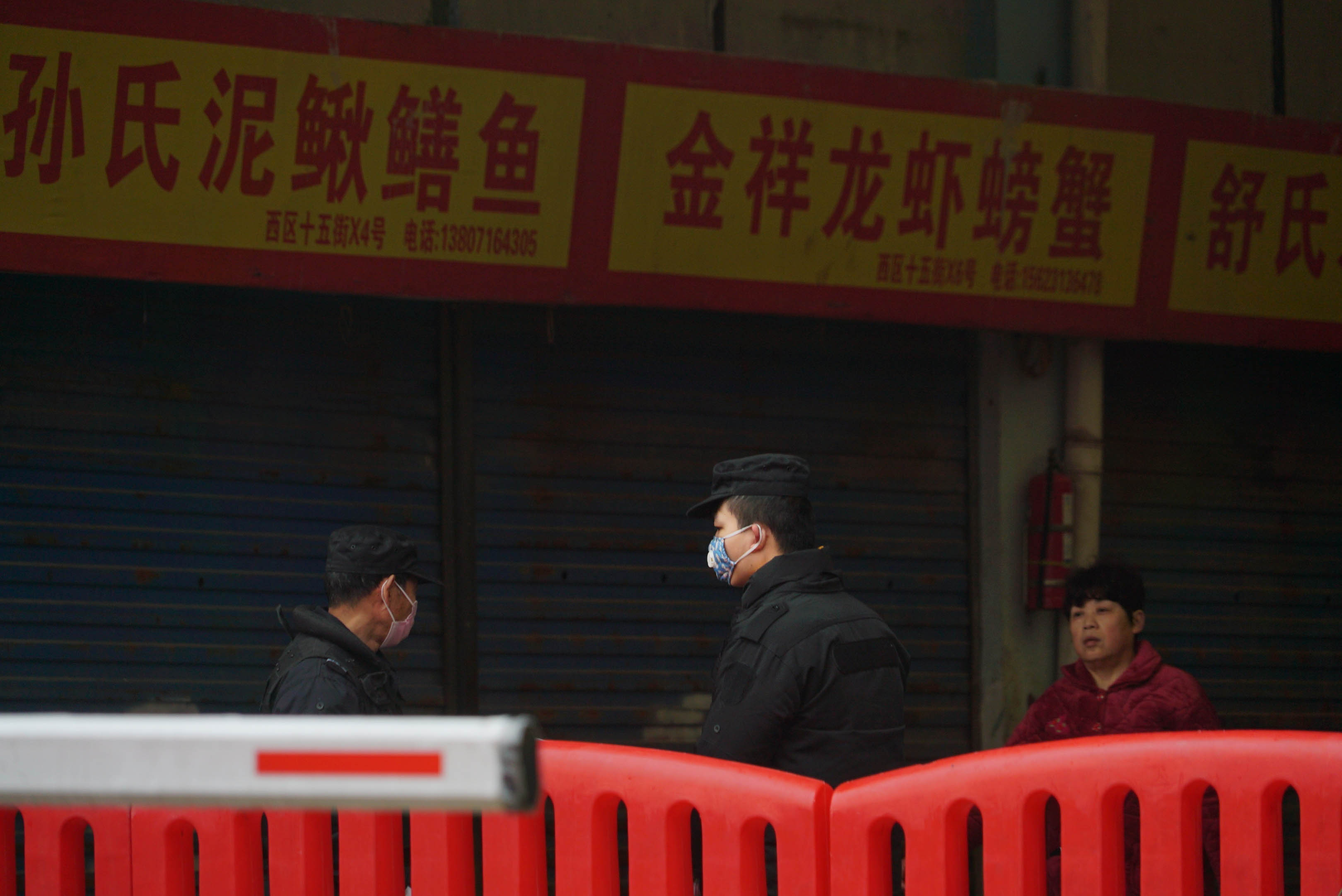
Trump’s coronavirus response includes many things he criticized President Obama for response:
https://plawiuk.blogspot.com/2020/02/trumps-coronavirus-response-includes.html
Infectious Disease Director at University of Nebraska contradicts Trump:
https://plawiuk.blogspot.com/2020/02/infectious-disease-director-at.html
Sanders blasts Trump’s coronavirus
https://plawiuk.blogspot.com/2020/02/sanders-blasts-trumps-coronavirus.html
Trump Ripped For Putting 'Science-Denier' Mike Pence In Charge Of Coronavirus
https://plawiuk.blogspot.com/2020/02/trump-ripped-for-putting-science-denier.html
Trump said coronavirus won’t spread — his scientists said the opposite right in front of him
https://plawiuk.blogspot.com/2020/02/trump-said-coronavirus-wont-spread-his.html
Trump's acting Homeland Security chief was excoriated by a GOP senator
https://plawiuk.blogspot.com/2020/02/trumps-acting-homeland-security-chief.html
CDC issues beard and mustache guide for coronavirus pandemic
https://plawiuk.blogspot.com/2020/02/beards-mustaches-and-respirators-oh-my.html
Coronavirus latest: Stark CDC, WHO warnings add to global gloom: 'This could be bad'
https://plawiuk.blogspot.com/2020/02/coronavirus-latest-stark-cdc-who.html
Kudlow: Coronavirus will not be economic tragedy
https://plawiuk.blogspot.com/2020/02/kudlow-coronavirus-will-not-be-economic.html
CORONA VIRUS MEME
https://plawiuk.blogspot.com/2020/02/the-corona-virus-satire-meme.html
A faulty CDC coronavirus test delays monitoring of disease’s spread
https://plawiuk.blogspot.com/2020/02/a-faulty-cdc-coronavirus-test-delays.html
The coronavirus cruise ship outbreak confirms cruises are bad
https://plawiuk.blogspot.com/2020/02/the-coronavirus-cruise-ship-outbreak.html
The coronavirus recession?
https://plawiuk.blogspot.com/2020/02/the-coronavirus-recession-jeff-spross.html
Coronavirus fatality rates vary wildly depending on age, gender and medical history
https://plawiuk.blogspot.com/2020/02/home-personal-finance-coronavirus.html
As coronavirus cases surge, the U.S. military prepares for possible pandemic
https://plawiuk.blogspot.com/2020/02/as-coronavirus-cases-surge-u.html
Trump's coronavirus response is worse than incompetent
https://plawiuk.blogspot.com/2020/02/trumps-coronavirus-response-is-worse.html
HHS Secretary Alex Azar reportedly blindsided by Trump putting Pence in charge of coronavirus response
https://plawiuk.blogspot.com/2020/02/hhs-secretary-alex-azar-reportedly.html

Effectiveness of travel bans—readily used during infectious disease outbreaks—mostly unknown, study finds
https://plawiuk.blogspot.com/2020/02/effectiveness-of-travel-bansreadily.html
Virus could mean $5 bn in airline losses: UN agency
https://plawiuk.blogspot.com/2020/02/virus-could-mean-5-bn-in-airline-losses.html
Q&A: Coronavirus likely to infect the global economy
https://plawiuk.blogspot.com/2020/02/fake-news-makes-disease-outbreaks-worse.html
Hundreds march in Hong Kong against potential coronavirus quarantine clinics
https://plawiuk.blogspot.com/2020/02/hundreds-march-in-hong-kong-against.html
I Am Watching China Wage Peoples War on Coronavirus
(65,000 Cases and Growing)
https://plawiuknd.blogspot.com/2020/02/i-am-watching-china-wage-peoples-war.html
China’s Leader, Uer Fire, Says He Led Coronavirus Fight Early On
https://plawiuk.blogspot.com/2020/02/chinas-leader-under-fire-says-he-led.html
Here’s How Scientists Think Coronavirus Spreads From Bats to Humans
https://plawiuk.blogspot.com/2020/02/heres-how-scientists-think-coronavirus.html
PANGOLIN
How love for an endangered animal inspired a new wave of coronavirus racism
https://plawiuk.blogspot.com/2020/02/how-love-for-endangered-animal-inspired.html
Fake news makes disease outbreaks worse, research shows
https://plawiuk.blogspot.com/2020/02/fake-news-makes-disease-outbreaks-worse.html
AFP Fact Check Busting coronavirus myth
https://plawiuk.blogspot.com/2020/02/afp-fact-check-busting-coronavirus-myths.html
Vancouver’s Chinese restaurants are empty amid coronavirus fears. If misinformation is to blame, so is China’s embassy
https://plawiuk.blogspot.com/2020/02/vancouvers-chinese-restaurants-are.html
THE ORIGIN OF THE CHINESE BIO WEAPON VIRUS CONSPIRACY THEORY
IS A NOVEL OF COURSE
https://plawiuk.blogspot.com/2020/02/the-origin-of-chinese-bio-weapon-virus.html
Coronavirus: From bats to pangolins, how do viruses reach us?
https://plawiuk.blogspot.com/2020/02/coronavirus-from-bats-to-pangolins-how.html
DOCTOR TRUMP & DR XI SAY; GLOBAL WARMING KILLS CORONOAVIRUS
https://plawiuk.blogspot.com/2020/02/doctor-trump-dr-xi-i-presume-drew.html
Coronavirus email hoax led to violent protests in Ukraine
https://plawiuk.blogspot.com/2020/02/coronavirus-email-hoax-led-to-violent.html
An official leading South Korea's battle against COVID-19 says he's a member of a doomsday cult
https://plawiuk.blogspot.com/2020/02/an-official-leading-south-koreas-battle.html
Trump’s flailing incompetence makes coronavirus even scarier
https://plawiuk.blogspot.com/2020/02/trumps-flailing-incompetence-makes.html
Will China's coronavirus outbreak send the world economy into recession?
https://plawiuk.blogspot.com/2020/02/will-chinas-coronavirus-outbreak-send.html
China’s Leader, Under Fire, Says He Led Coronavirus Fight Early On
https://plawiuk.blogspot.com/2020/02/chinas-leader-under-fire-says-he-led.html
Trump Bans Corona Beer To Stop Spread Of The Super Virus
https://plawiuk.blogspot.com/2020/02/trump-bans-corona-beer-to-stop-spread.html






/cdn.vox-cdn.com/uploads/chorus_image/image/66440342/GettyImages_643959858.0.jpg)

/cdn.vox-cdn.com/uploads/chorus_image/image/66225979/GettyImages_1203669279.26.jpg)
:no_upscale()/cdn.vox-cdn.com/uploads/chorus_asset/file/19767730/Screen_Shot_2020_03_04_at_3.02.26_PM.png)
:no_upscale()/cdn.vox-cdn.com/uploads/chorus_asset/file/19733997/Screen_Shot_2020_02_20_at_11.56.48_AM.png)
:no_upscale()/cdn.vox-cdn.com/uploads/chorus_asset/file/19734231/Screen_Shot_2020_02_20_at_1.09.28_PM.png)
:no_upscale()/cdn.vox-cdn.com/uploads/chorus_asset/file/19660010/Screen_Shot_2020_01_30_at_7.03.03_PM.png)
:no_upscale()/cdn.vox-cdn.com/uploads/chorus_asset/file/19659112/Screen_Shot_2020_01_30_at_2.05.53_PM.png)
:no_upscale()/cdn.vox-cdn.com/uploads/chorus_asset/file/19659868/Screen_Shot_2020_01_30_at_3.14.47_PM.png)
:no_upscale()/cdn.vox-cdn.com/uploads/chorus_asset/file/19659842/Screen_Shot_2020_01_30_at_5.58.34_PM.png)
:no_upscale()/cdn.vox-cdn.com/uploads/chorus_asset/file/19659805/Screen_Shot_2020_01_30_at_7.52.21_AM.png)
:no_upscale()/cdn.vox-cdn.com/uploads/chorus_asset/file/19660020/Screen_Shot_2020_01_30_at_7.12.00_PM.png)
:no_upscale()/cdn.vox-cdn.com/uploads/chorus_asset/file/19659921/Screen_Shot_2020_01_30_at_3.25.54_PM.png) Twitter shows a banner linking to the Centers for Disease Control and Prevention when you search for “coronavirus” on the platform.
Twitter shows a banner linking to the Centers for Disease Control and Prevention when you search for “coronavirus” on the platform.